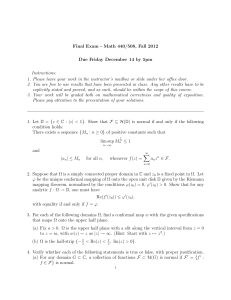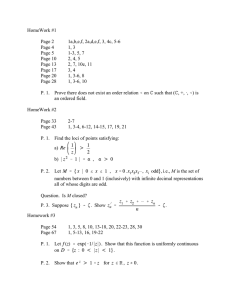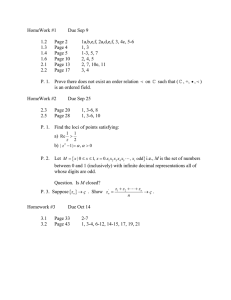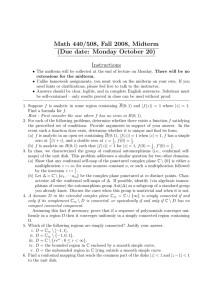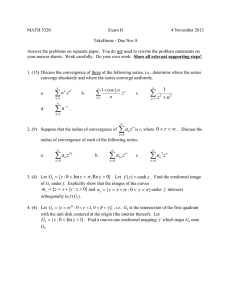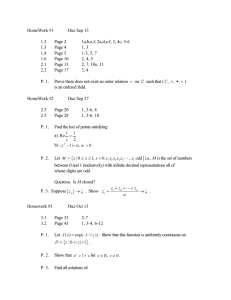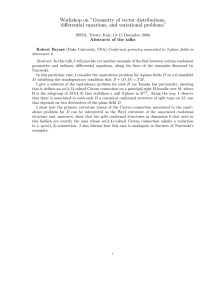WHEN ELLIPSES LOOK LIKE
advertisement
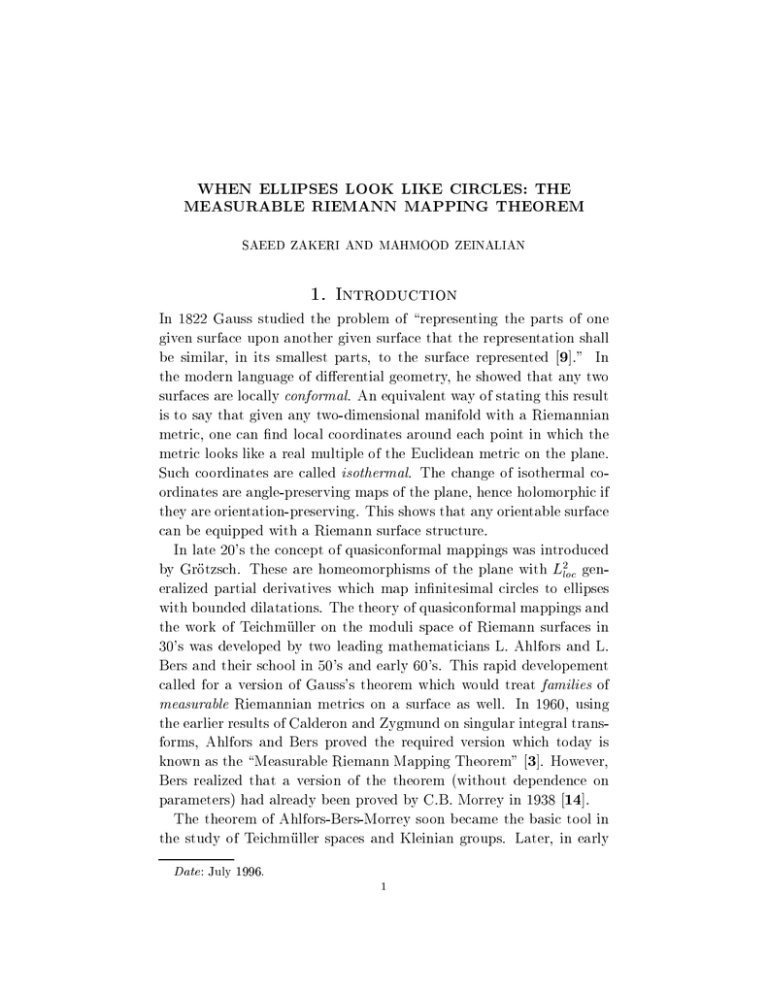
WHEN ELLIPSES LOOK LIKE CIRCLES: THE MEASURABLE RIEMANN MAPPING THEOREM SAEED ZAKERI AND MAHMOOD ZEINALIAN 1. Introduction In 1822 Gauss studied the problem of \representing the parts of one given surface upon another given surface that the representation shall be similar, in its smallest parts, to the surface represented [9]." In the modern language of dierential geometry, he showed that any two surfaces are locally conformal. An equivalent way of stating this result is to say that given any two-dimensional manifold with a Riemannian metric, one can nd local coordinates around each point in which the metric looks like a real multiple of the Euclidean metric on the plane. Such coordinates are called isothermal. The change of isothermal coordinates are angle-preserving maps of the plane, hence holomorphic if they are orientation-preserving. This shows that any orientable surface can be equipped with a Riemann surface structure. In late 20's the concept of quasiconformal mappings was introduced by Grotzsch. These are homeomorphisms of the plane with L2loc generalized partial derivatives which map innitesimal circles to ellipses with bounded dilatations. The theory of quasiconformal mappings and the work of Teichmuller on the moduli space of Riemann surfaces in 30's was developed by two leading mathematicians L. Ahlfors and L. Bers and their school in 50's and early 60's. This rapid developement called for a version of Gauss's theorem which would treat families of measurable Riemannian metrics on a surface as well. In 1960, using the earlier results of Calderon and Zygmund on singular integral transforms, Ahlfors and Bers proved the required version which today is known as the \Measurable Riemann Mapping Theorem" [3]. However, Bers realized that a version of the theorem (without dependence on parameters) had already been proved by C.B. Morrey in 1938 [14]. The theorem of Ahlfors-Bers-Morrey soon became the basic tool in the study of Teichmuller spaces and Kleinian groups. Later, in early Date : July 1996. 1 2 S. Zakeri and M. Zeinalian 80's, Sullivan, Shishikura, Douady and Hubbard used the theorem in quasiconformal surgery and the study of iteration of rational functions on the sphere. It turned out that quasiconformality is the exact level of regularity one needs in the course of a surgery. The fact that the conformal structures involved in the theorem are only measurable exhibits its extremely exible nature as a tool for surgery. This idea led to the proof of two old conjectures in conformal dynamics [16],[18] and was the origin of the theory of polynomial-like maps [7]. The goal of this paper is to give a self-contained expository account of what this theorem is about, and to show a few applications. 2. Conformal Structures on Surfaces Let us consider a C 1 smooth, connected, oriented surface X . A conformal structure on X is an equivalence class of measurable Riemannian metrics in the following sense: If a metric g has the local expression g (x; y ) = E (x; y )dx2 + 2F (x; y )dxdy + G(x; y )dy 2; then g is called measurable if E; F; and G are (Lebesgue) measurable functions of x; y such that E > 0, G > 0, and EG F 2 > 0 almost everywhere. Two metrics g1 and g2 are said to be equivalent i g1 = g2 for some positive measurable function on X . Thus, the notion of the angle between two tangent vectors at almost every point is well-dened in the conformal class of a particular metric. Now suppose in addition that X is a Riemann surface, i.e., suppose that there is a complex structure A (a maximal C -analytic atlas) associated to X . In this case it is much more useful to choose the usual complex-variable notation for our metrics. A metric g can then be written as g (z ) = (z )jdz + (z )dzj2 ; (1) where z = x + iy; and are measurable functions of z , (z ) > 0 and j(z )j < 1 for almost every z (cf. Appendix A). It is easily seen that (z ) is not a well-dened function on X . However, the expression (z )dz=dz is well-dened under holomorphic change of coordinates. In fact, if z 7! w is a change of coordinates on X and if g in (1) has the Measurable Riemann Mapping Theorem 3 local expression ~ (w)jdw + ~(w)dwj2 in w, then ~(w) = (z ) (dw=dz ) ; (dw=dz ) (2) from which it follows that (z )dz=dz = ~(w)dw=dw . The expression dz = (z ) dz is called the Beltrami dierential of the metric g . From the denition of a conformal structure and (1) it follows that depends only on the conformal class of g . Conversely, given any measurable Beltrami dierential , we can consider the associated conformal structure which is the conformal class of the metric jdz + (z )dzj2 . As a result, on a Riemann surface there is a one-to-one correspondence between conformal structures and Beltrami dierentials. Fixing the complex structure A on X , we can associate a conformal structure to X whose Beltrami dierential is identically zero in every local coordinate belonging to A. This conformal structure is called the standard conformal structure of X . We will always denote this structure by X . A typical metric in X would then look like (z )jdz j2 in every local coordinate z in A. We have just seen that a conformal structure on a Riemann surface X can be described in a one-to-one fashion by a Beltrami dierential on X . Here is a natural question: How could one give a geometric description of a conformal structure on X ? Answer: Just take a look at the \eld of ellipses" of vectors of constant length on each tangent plane. Let us elaborate this in more details. Consider a conformal structure on X whose Beltrami dierential is . For almost every z in X , we can form concentric ellipses jjvjj =constant for v in Tz X , the tangent plane to X at z (see gure 1). Note that these concentric ellipses depend only on since any Riemannian metric in this conformal structure is a real multiple of any other when restricted to Tz X . It is easy to understand the geometry of these ellipses in terms of . Consider a tangent vector v = u@=@x + v@=@y in Tz X . Passing to complex-variable notation, the condition jjvjj = c means j(u + iv ) + (z )(u iv )j = c (cf. Appendix A). If u + iv = rei , this reduces to j1 + j(z )jei(arg (z) 2) j = c=r. So the 4 S. Zakeri and M. Zeinalian ||v||= const. θ Tz X Figure 1 ratio of the major axis to the minor axis of this ellipse, measured in the standard conformal structure X , is K (z ) = 1 + j(z )j 1 j(z )j (3) and the angle of elevation of the minor axis with respect to the horizontal direction in this particular local coordinate is (z ) = 1 arg (z ): 2 (4) From (3) it follows in particular that j(z )j is a well-dened measurable function on X (as can also be seen from the transformation rule (2)). It also shows that we get \circles" if we consider the ellipses coming from X . Conversely, given any measurable eld of ellipses on X , i.e., a family of concentric ellipses on almost every tangent plane varying in a measurable way, we can nd a conformal structure by going backward: Measure the ratio of the major axis to the minor axis in the standard conformal structure to obtain K and measure the angle in a particular local coordinate z . Then from (3) and (4) nd (z ). The conformal structure will then be the conformal class of jdz + (z )dzj2 . As a result, conformal structures on X and measurable elds of ellipses on the tangent planes of X are in fact the same objects. Measurable Riemann Mapping Theorem 5 A measurable eld of ellipses is said to have bounded dilatation with respect to X if jjK jj1 < +1, where jj:jj1 denotes the essential supremum over X . This means that the ellipses cannot be distorted arbitrarily large. We are allowed to make an error in drawing our `circles' only within a certain bounded range. From (3) it is natural to dene a conformal structure of bounded dilatation with respect to X as one whose Beltrami dierential satises jjjj1 < 1: As an example, the conformal class of z2 2 jdz + jzj dzj (5) does not have bounded dilatation on the unit disk D = fz : jz j < 1g (see gure 2). Figure 2 Yet another way of describing a conformal structure on a Riemann surface is through an algebraic approach. Fix a conformal structure on X and consider its eld of ellipses on almost every tangent plane Tz X . We can dene an R -linear isomorphism J on Tz X such that J2 = identity. To this end, pick an orthogonal pair (e1 ; e2 ) as in the gure and let J (e1 ) = e2 and J (e2 ) = e1 , and extend J by 6 S. Zakeri and M. Zeinalian linearity. It is clear that J constructed in this way does not depend on the choice of the ellipse where (e1 ; e2 ) was picked up. Such family of linear maps is an example of a measurable almost-complex structure. Strictly speaking, a measurable almost-complex structure on X is a rule z 7! J (z ) which assigns to almost every z on X an R -linear isomorphism J (z ) on Tz X in a measurable fashion such that J (z )2 = identity. For example, the almost-complex structure induced by X sends @=@x to @=@y and @=@y to @=@x in every local coordinate z = x + iy . In the complex-variable notation, therefore, it sends @=@z to i@=@z (cf. Appendix A). For this reason, we usually regard it as the \multiplication by i" or the \rotation by 90Æ " in the positive direction on Tz X . Conversely, consider a measurable almost-complex structure z 7! J (z ) such that the orientation of the pair (@=@x; J (@=@x)) is the same as (@=@x; @=@y ) for almost every z on X . Fix a typical z and pick an R -linear isomorphism on Tz X such that 1 J (z )(@=@x) = @=@y and 1 J (z )(@=@y ) = @=@x. In other words, conjugates the action of J with the multiplication by i. Consider concentric circles on Tz X coming from X and take their image under . The resulting concentric ellipses are well-dened since they depend neither on the local coordinate z nor on the choice of . Each ellipse is preserved under J (z ). In this way we obtain a eld of ellipses, hence a conformal structure, out of an almost-complex structure (see gure 3). rotation by 90 o J(z) e2 e1 φ Tz X Tz X Figure 3 Measurable Riemann Mapping Theorem 7 Now let us dene an operation on conformal structures which corresponds to pulling back the Riemannian metrics in dierential geometry. Roughly speaking, we can pull back a conformal structure by any smooth dieomorphism, but because of the measurable nature of our objects, we can relax the condition of being smooth. For a moment, let X and Y be two Riemann surfaces and let f : X ! Y be an orientation-preserving dieomorphism. Given any conformal structure on Y we can pull it back to get a conformal structure f on X . In fact, if is the conformal class of jdw + (w)dw j2 and if w = f (z ) is the local expression of f , then f will be the conformal class of jdz + ffz ++ ((ff ((zz))))ffz dzj2 z z where fz and fz are complex partial derivatives of f in local coordinate z (cf. Appendix A). In particular, if Y is the standard conformal structure of Y , then f Y = conformal class of jdz + fz 2 dzj : fz (6) The Cauchy-Riemann equations will then show that f : X ! Y is a conformal map i f Y = X . In the language of almost-complex structures, this means that the derivative Df (z ) as an R -linear map Tz X ! Tf (z) Y commutes with the corresponding multiplications by i: Tz X J# Tz X ! Df (z ) ! Df (z ) Tf (z) Y # J0 Tf (z) Y Now, all conformal structures are only measurable and it seems rather awkward to use smooth maps to pull them back. In fact, the same kind of operations as above can be dened even if f is not a dieomorphism. But in order to extend the class of maps for which the pull-back of conformal structures makes sense, we have to pick up those homeomorphisms for which the partial derivatives exist in some reasonable sense. It turns out that such homeomorphisms do exist: They are the so-called quasiconformal homeomorphisms. Strictly speaking, a homeomorphism f : X ! Y is called quasiconformal if at almost every point it has locally square-integrable generalized partial derivatives fz and fz in every local coordinate z (cf. 8 S. Zakeri and M. Zeinalian Appendix B) and jj ffz jj1 < 1: (7) z Then we can imitate the case of a dieomorphism to pull a conformal structure back by f , so the formula (6) still holds. As a result, f : X ! Y is quasiconformal i f Y has bounded dilatation with respect to X : What is more exciting is the fact that even for a quasiconformal homeomorphism f : X ! Y , f Y = X implies f is conformal. In other words, a quasiconformal homeomorphism f with fz = 0 is actually holomorphic, which is a generalization of Cauchy-Riemann equations for homeomorphisms. This fact is known as Weyl's Lemma. The quantity on the left side of (7) is called the maximal dilatation of f . By Weyl's lemma, f is conformal i its maximal dilatation is zero. Quasiconformal homeomorphisms have extraordinary analytic properties. They can also be characterized by simple geometric properties for which we refer the reader to [2] (see also Appendix B, Theroem B-1). Now, let us stop for a moment and look at what we have already constructed. From a complex structure on a surface we can construct a (standard) conformal structure, or equivalently a eld of ellipses, or equivalently an almost-complex structure: Complex Structures Conformal Structures Fields of Ellipses Almost-Complex Structures Figure 4 Here we come up with the most delicate question: Is it possible to draw an arrow from downstairs to upstairs in this diagram? In other words, is it true that given (a) a conformal structure , or (b) a measurable eld of ellipses, or Measurable Riemann Mapping Theorem 9 (c) a measurable almost-complex structure J on a surface X , one can nd a complex structure A on X such that (a') is the standard conformal structure of (X; A)? or (b') the circles in the tangent planes of (X; A) are the given ellipses? or (c') the action of J is the same as multiplication by i in (X; A)? 3. The Theorem The Measurable Riemann Mapping Theorem provides a complete answer to the above question. It turns out that the answer is aÆrmative provided that we impose a boundedness condition on the given conformal structure. Roughly speaking, the theorem says that the answer is positive if the conformal structure has a reasonable deviation from the standard conformal structure of some complex structure on the surface. In other words, if there is a complex structure on X such that has bounded dilatation with respect to X , then we can re-dene the complex structure of X such that is standard in the new C -analytic atlas. In this case , or the eld of ellipses, or the almost-complex structure, is called integrable. Let us formulate this question in a more convenient language. Let X be given a xed complex structure and let have bounded dilatation with respect to X . Fact(y) To say that is integrable means that there exists a Riemann surface Y and a quasiconformal homeomorphism f : X ! Y such that f Y = . In fact, if f is such a map, equip X with the pull-back complex structure (whose charts are f composed with the charts of Y ). Then is standard in this new complex structure. On the other hand, if is standard in some new complex structure on X , call this new Riemann surface Y and consider the identity map id : X ! Y . Obviously, (id)Y = . Moreover, it is easy to prove the uniqueness of such Y (if any). If g : X ! Z is another quasiconformal homeomorphism with g Z = , then h = g Æ f 1 : Y ! Z satises h Z = Y , so it is conformal. Conversely, if h : Y ! Z is a conformal homeomorphism, then g = h Æ 10 S. Zakeri and M. Zeinalian f : X ! Z satises g Z = . We conclude that the solution f : X ! Y is unique up to post-composition with a conformal homeomorphism of Y. As the basic case, let us assume that X = D , the unit disk in the complex plane. Let have bounded dilatation with respect to D , which means the corresponding Beltrami dierential satises jjjj1 < 1. Then by (6) a quasiconformal homeomorphism f : D ! Y satises f Y = i it is a solution of the equation fz = ; fz jjjj1 < 1 which is called the Beltrami equation. Local solutions of this equation were found by Gauss for a real analytic . Beltrami himself extensively used the equation in his works on surface theory [4]. C.B. Morrey was the rst who proved the existence of global solutions of the Beltrami equation for measurable . Nevertheless, his proof had been overlooked by Ahlfors and many others for almost 20 years since it was totally written in the language of partial dierential equations. The early version of the proof for Holder continuous was already published by Ahlfors when Bers realized the connection of Morry's work with quasiconformal mappings. In their 1960 fundamental paper, Ahlfors and Bers proved a much more powerful version which also gives analytic dependence on parameters. This seemingly technical improvement turned out to be of tremendous importance for the theory of Teichmuller spaces. According to the uniformization theorem, the Riemann surface Y above is conformally equivalent to either D or the complex plane C . But the theorem shows that Y can always be chosen to be D , which means that the Beltrami equation has solutions f which are quasiconformal homeomorphisms D ! D . This will show that Y can never be C , i.e., there is no quasiconformal homeomorphism between D and C (see Corollary 1 below). Theorem 1 (Ahlfors-Bers-Morrey). Let be a measurable con- formal structure of bounded dilatation on the unit disk D . Then there exists a quasiconformal homeomorphism f : D ! D with f D = . f is unique up to post-composition with a conformal homeomorphism of D . Moreover, if f t g is a family of such conformal structures which depends continuously, smoothly, or analytically on a parameter t, then Measurable Riemann Mapping Theorem 11 there exists a family ff t g of quasiconformal homeomorphisms of D with (f t ) D = t which depends on t in the same way as f t g does. As a simple consequence of the theorem, we have the following Corollary 1. There is no quasiconformal homeomorphism between D and C . In fact, let g : D ! C be such a homeomorphism. Then g C has bounded dilatation with respect to D . By the theorem above, there is f : D ! D such that f D = g C , or (f Æ g 1 ) D = C . But this means that f Æ g 1 : C ! D is conformal, hence constant by Liouville's theorem. It might seem that there are genuine global obstructions to integrability for a general Riemann surface. But that is just not true. In fact the general case is a consequence of the `local' case X = D . Let X be an arbitrary Riemann surface with a C -analytic atlas A. Let be a measurable conformal structure of bounded dilatation with respect to X . Cover X by a countable union of charts (U; z ) in A, where z : U ! D is a homeomorphism. In each such local coordinate, is the conformal class of jdz + (z )dzj2 with z in D and jjjj1 < 1. By the above theorem, there is a quasiconformal homeomorphism f : D ! D such that f D = : Choose (U; f Æ z ) as a chart in a new atlas B . If (V; w) is also in A with U \ V 6= ; and if (V; g Æ w) is the corresponding new chart in B, then the change of coordinate (g Æ w) Æ (f Æ z ) 1 is conformal since it preserves D : [(g Æ w) Æ (f Æ z ) 1 ] D = (f 1 ) (w Æ z 1 ) g D = (f 1 ) (w Æ z 1 ) = (f 1 ) = D : Therefore B is actually a C -analytic atlas on X with respect to which is standard. By fact (y) above, we have proved Theorem 2. Let X be a Riemann surface and be a measurable con- formal structure of bounded dilatation with respect to X . Then there exists a Riemann surface Y and a quasiconformal homeomorphism f : X ! Y such that f Y = . f is unique up to post-composition with a conformal homeomorphism of Y. 12 S. Zakeri and M. Zeinalian When X is the Riemann sphere C , it follows from the uniformization theorem that every Riemann surface Y homeomorphic to X is in fact conformally equivalent to X . Moreover, every conformal homeomorphism of the sphere is a complex Mobius transformation which is uniquely determined by its image at 3 distinct points. Consequently, one has Theorem 3. Let be a measurable conformal structure of bounded di- latation on the Riemann sphere C . Then there exists a unique quasiconformal homeomorphism f : C ! C with f (0) = 0; f (1) = 1; f (1) = 1 such that f C = . The proof of Theorem (2) also reveals the following fact. If we consider a conformal class of continuous Riemannian metrics on a Riemann surface, we do not have to impose any boundedness condition on it. In fact, given any such conformal class on X , we equip X with an arbitrary complex structure and we take a covering of X by a bunch of disks compactly contained in a given covering. It follows that the function jj is uniformly less than 1 on each disk. Then we repeat the same argument as before. Corollary 2. Every continuous conformal structure on a smooth surface is integrable. As an example, the conformal structure (5) on D does not have bounded dilatation with respect to D . Nevertheless, it is continuous and so integrable. It can be checked that the Riemann surface on which (5) is standard is conformally equivalent to C . In fact, the function f (z ) = z (1 jz j) 2 denes the required conformal homeomorphism D ! C. 4. An Application: Polynomial-Like Maps There have been several results in conformal dynamics in recent years whose proofs use the measurable Riemann mapping theorem in an essential way. These include Sullivan's proof of the no wandering domain conjecture [18], Shishikura's sharp estimates on the number of Measurable Riemann Mapping Theorem 13 non-repelling cycles of a rational map on the sphere [16], construction of Herman rings by quasiconformal surgery [16], and the theory of polynomial-like maps of Douady and Hubbard [7] which is an important tool for studying the quadratic family fz 7! z 2 + cg and the Mandelbrot set. Here we give a basic application of Theorem 3 in the theory of polynomial-like maps. Let P be a polynomial of degree d > 1 with complex coeÆcients. For large jz j, it behaves like z 7! cz d . Therefore, for large R > 0, it maps the disk U = fz : jz j < Rg onto a larger topological disk V with V U and P : U ! V is a d-to-1 proper holomorphic map. We dene the lled Julia set K (P ) as the set of all points x whose orbit fP n(x)gn0 remains bounded in C : \ n K (P ) = P (U ): n0 This is a compact subset of U which is usually wild, fractal-shaped. The behavior of polynomials for large jz j suggests that we study the following situation: Let U and V be open topological disks with smooth boundaries such that U V . Let f : U ! V be a proper holomorphic map of degree d > 1. We call f a polynomial-like map. Imitating the polynomial case, we dene the lled Julia set K (f ) as the set of all x in U whose orbit under f never leaves U . Specically, K (f ) = \n0 f n (U ). We want to show that a polynomial-like map has the same iterative behavior as an actual polynomial near the corresponding lled Julia sets. In fact we show that there is a quasiconformal conjugacy between any polynomial-like map and an actual polynomial which is conformal in the interior of the lled Julia sets. In this case, we say that the two maps are hybrid equivalent. Theorem 4 (Douady-Hubbard). Let f : U ! V be a polynomiallike map of degree d > 1. Then there exists a polynomial P of degree d and a quasiconformal homeomorphism : C ! C with (1) = 1 which conjugates f and P in a neighborhood of their lled Julia sets: (f (z )) = P ((z )): Moreover, z = 0 on K (f ), so the conjugacy is conformal in the interior of K (f ). 14 S. Zakeri and M. Zeinalian The key point is to extend the action of f to the whole sphere by gluing it to the polynomial z 7! z d . Then we dene an invariant conformal structure on the sphere and use Theorem 3 to show that it is integrable. To this end, let h : C nV ! fz : jz j 2g be a conformal homeomorphism with h(1) = 1, and extend it in a smooth way to a dieomorphism h : C nU ! fz : jz j 21=d g such that h(f (z )) = (h(z ))d z Now the smooth function f~(z ) = f (z ) z 1 d h Æ (h(z )) z 2 @U: 2U 2 C nU V P 8 8 is the desired extension of f which is conformally conjugate to z 7! z d outside of V . Dene a measurable conformal structure on the sphere as follows. Let be C on C nV . We can pull it back from C nV to V nU by f~ to dene there. Next, we dene on U nf (U ) as the pull-back of on V nU by f~. This process of taking pull-backs can be continued to dene everywhere except K (f ). We simply put = C on K (f ). Note that obtained in this way is invariant under f~ and has bounded dilatation, since after the rst step, all successive pull-backs are done by a holomorphic map which does not change the dilatation. U f φ K Figure 5 By Theorem 3 there is a quasiconformal homeomorphism : C ! C xing 1 such that C = . Since is invariant under f~, C will be invariant under P = Æ f~ Æ 1 , so P is holomorphic. Also P is a d-to-1 proper map xing 1. Therefore P is a polynomial of degree d. Measurable Riemann Mapping Theorem 15 Note that z = 0 on K (f ) since was dened to be standard there. 5. Further Readings This paper in only an introduction to the very basic features of the measurable Riemann mapping theorem. Here we briey mention a few references which cover most of the topics we touched in this paper. Gauss's proof of the existence of isothermal coordinates can be found in his collected works [9]. There is an English translation of the main part of his paper in [17]. There is a nice proof due to Douady and Fathi of the existence of solutions of the Beltrami equation (without dependence on parameters) in [6]. They rst prove the result for an analytic using a complex-time ordinary dierential equation and then they apply standard approximation techniques to nd the solution in the general case. The general problem of integrability of smooth almost-complex structures is answered by a fundamental theorem of Newlander-Nirenberg [15] which gives a simple proof in the smooth two-dimensional case. The most comprehensive study of quasiconformal maps can be found in [12]. For an excellent short introduction, including a proof of Theorem 1 in this paper and basic applications to Teichmuller theory, see [2]. Another topic of main interest is the theory of quasiconformal maps in higher dimensions [10]. Teichmuller theory is the study of the space of quasiconformal deformations of a Riemann surface. It has emerged naturally as an attempt to answer Riemann's moduli problem for compact surfaces. Good introductions to this subject with applications to quadratic dierentials and Fuchsian groups can be found in [1], [8], and [11]. A major area in which quasiconformal maps have been successfully applied is conformal dynamics. For an excellent introduction to classical Fatou-Julia theory, see [13]. Standard applications of quasiconformal maps in conformal dynamics include [7], [16], and [18]. For a general exposition of how to use quasiconformal maps in dynamics (and some other areas) see [19]. Techniques of Teichmuller theory have nice applications in renormalization theory, for which we refer to the last chapter of [5]. 16 S. Zakeri and M. Zeinalian Appendix A. Complex-Variable Notations on a Surface Let X be a C 1 smooth, connected, oriented surface. T X , the real rank 2 tangent bundle of X , and its dual T X , the real rank 2 cotangent bundle of X , can be complexied by taking the tensor products TC X = T X C and TC X = T X C . Therefore, in a local coordinate (x; y ) on X , a typical section of TC X and TC X can be written as u(x; y ) and @ @ + v (x; y ) ; @x @y u(x; y )dx + v (x; y )dy respectively, where u and v are smooth, complex-valued functions of x and y . We dene two special sections dz = dx + idy and dz = dx idy; which form a basis for TC X in every local coordinate (x; y ). We use notations @=@z and @=@ z for the dual basis in the same local coordinate: @ ) = 1; @z @ dz( ) = 0; @z dz ( Therefore @ ) = 0; @ z @ dz( ) = 1: @ z dz ( 1 @ @ @ 1 @ @ @ = ( i ) and = ( + i ): @z 2 @x @y @ z 2 @x @y We may regard @=@z and @=@ z as dierential operators acting on smooth functions f : U ! C , where U is the domain on which the local coordinate (x; y ) is dened. The action is simply dened by @f 1 @f = ( @z 2 @x i @f ) and @y @f 1 @f @f = ( + i ): @ z 2 @x @y We usually use indices for partial derivatives, like fz for @f =@z , etc. Now the dierential df of a function f satises df = fx dx + fy dy = fz dz + fzdz: When X has a complex structure which makes it into a Riemann surface, the complex one-dimensional subspace generated by @=@z in every local coordinate z = x + iy denes a sub-bundle of TC X which we denote by Thol X . This follows at once from the fact that the change of coordinates are holomorphic. Thol X is isomorphic to T X as a real rank Measurable Riemann Mapping Theorem 17 2 bundle via @=@z 7! @=@x and i@=@z 7! @=@y . It follows from CauchyRiemann equations that a function f is holomorphic i in every local coordinate z = x + iy , fz = 0, or df belongs to the cotangent bundle X. Thol Back to the case of a smooth surface. A measurable Riemannian metric on X can be locally written as g = Edx2 + 2F dxdy + Gdy 2; (8) where E; F; and G are (Lebesgue) measurable functions of x; y such that E > 0, G > 0, and EG F 2 > 0 almost everywhere. The length of a tangent vector v=u is given by @ @ +v @x @y jjvjj2 = Eu2 + 2F uv + Gv2 : If we use complex notation, the vector v has a representation @ @ + (u iv ) : @z @ z A direct calculation shows that g in (8) can be expressed as v = (u + iv ) g (z ) = (z )jdz + (z )dzj2 ; where z = x + iy and 1 E+G p + EG (z ) = 2 2 (9) (10) F2 ; 1 E G F (z ) = +i : (z ) 4 2 It is easy to check that > 0 and jj < 1 almost everywhere. The expression in (10) means that the length of a tangent vector v in (9) satises jjvjj2 = j(u + iv) + (u iv)j2: The metric g is called conformal in the local coordinate z if (z ) 0, so that it takes the form (z )jdz j2 . This notion is not well-dened in the case of a surface for which the change of coordinates are just smooth dieomorphisms. In fact, if z 7! w is such a change of coordinates, the metric in w will take the form g (w) = (w)jzw dw + zw dwj2 = (w)jzw j2 jdw + zw dwj2 ; zw 18 S. Zakeri and M. Zeinalian which is not conformal in w. However, if X is equipped with a complex structure which makes it into a Riemann surface, the change of coordinates are holomorphic and so zw = 0, which shows that the metric will be conformal in w, too. Therefore, on a Riemann surface the notion of a conformal metric does not depend on the particular choice of the local coordinates. Appendix B. Quasiconformal Homeomorphisms Here we give equivalent denitions for quasiconformality in the planar case. These `local' denitions can then be used to dene the concept of quasiconformality on Riemann surfaces (cf. [2],[12]). In what follows we always assume that f : U ! V is an orientationpreserving homeomorphism between two regions in the plane. The homeomorphism f is said to have generalized partial derivatives if there exist integrable functions and such that Z U Z h dxdy = U f hz dxdy and Z U h dxdy = Z U f hz dxdy; for every smooth function h : U ! C with compact support. In this case we write = fz and = fz in the generalized sense. We say that f has locally square-integrable generalized par1 tial derivatives, and we write f 2 Wloc , if it has generalized partial derivatives fz and fz in U and for every compact set E U we have Z jfz j 2 E f is called dxdy < 1 and Z E jfzj2 dxdy < 1: absolutely continuous on lines if its restriction to almost every horizontal and vertical line in U is absolutely continuous. It follows from classical real analysis that the partial derivatives fx and fy , and so fz and fz, exist almost everywhere in U . An annulus is a subset of the plane homeomorphic to a `round' annulus A(1; r) = fz : 1 < jz j < rg. We set A(1; 1) = fz : jz j > 1g. It follows from the uniformization theorem that any annulus A is conformally homeomorphic to a unique A(1; r); 1 < r 1. We then dene the modulus of A by mod(A) = 1 log r; 2 Measurable Riemann Mapping Theorem 19 where log 1 = 1. It follows that the modulus is a conformal invariant: Two annuli A and A0 are conformally homeomorphic i mod(A)=mod(A0). The following theorem can be used as the denition of quasiconformality. Theorem B-1. Let morphism f : U (i) f !V K 1. For an orientation-preserving homeo- the following conditions are equivalent: 1 2 Wloc1 and j ffz j K almost everywhere in U, K +1 z (ii) f is absolutely continuous on lines and erywhere in U, 1 j ffz j K almost evK +1 z (iii) For every annulus A U , K 1 mod(A) mod(f (A)) K mod(A), (iv) For almost every x in U, lim supr!0 K: maxfjf (x) f (y )j : jx min fjf (x) f (y )j : jx y j = rg y j = rg The homeomorphism f is called K -quasiconformal if it satises any (hence all) of the above conditions. Denition. Let f : X ! Y be an orientation-preserving homeomorphism between Riemann surfaces. f is called K -quasiconformal if its local representations in charts of X and Y are all K -quasiconformal homeomorphisms of planar regions. It is called quasiconformal if it is K -quasiconformal for some K 1. It is easy to see that this denition coincides with one we gave earlier in terms of the pull-back of conformal structures. The following theorem summarizes the basic properties of quasiconformal homeomorphisms. Theorem B-2. Y is K1 -quasiconformal and g : Y ! Z is K2 quasiconformal, then g Æ f : X ! Z is K1 K2 -quasiconformal. (b) f : X ! Y is K-quasiconformal i f 1 : Y ! X is K-quasiconformal. (c) f : X ! Y is 1-quasiconformal i f is conformal. (a) If f : X ! 20 S. Zakeri and M. Zeinalian (d) If f is quasiconformal, then fz 6= 0 almost everywhere. (e) If f is quasiconformal, then it maps sets of measure zero to sets of measure zero. Acknowledgement. We would like to thank S. Shahshahani, F. Gardiner, and B. Maskit for their useful suggestions. References [1] Abiko, W., The Real Analytic Theory of Teichmuller Spaces, Lecture notes in mathematics 820, Springer-Verlag, 1980. [2] Ahlfors, L., Lectures on Quasiconformal Mappings, Van NostrandReinhold, Princeton, 1966. [3] Ahlfors, L. and Bers, L., Riemann mapping's theorem for variable metrics, Annals of Math., 72(1960) 385-404. [4] Beltrami, E., Ricerce di analisis applicata alla geometria, G. Mat. Battaglini, 2(1864). [5] de Melo, W. and van Strien, S., One-Dimensional Dynamics, Springer-Verlag, 1993. [6] Douady, A. and Fathi, A., Notes on quasiconformal mappings, University of Paris 11, Orsay, 1990. [7] Douady, A. and Hubbard, J., On the dynamics of polynomial-like mappings, Ann. Sc. Ecole Norm. Sup., (4)20(1985) 287-343. [8] Gardiner, F., Teichmuller Theory and Quadratic Dierentials, Wiley-Interscience, 1987. [9] Gauss, C. F., Werke IV, 193-216. [10] Gehring, F., Topics in quasiconformal mappings, Proceedings of the International Congress of Mathematicians, Berkeley, vol.I, 1986, 62-80. [11] Lehto, O., Univalent Functions and Teichmuller Spaces, SpringerVerlag, 1987. [12] Lehto, O. and Virtanen, K., Quasiconformal Mappings in the Plane, Springer-Verlag, 1973. [13] Milnor, J., Dynamics in One Complex Variable: Introductory Lectures, Institute for Mathematical Sciences, SUNY Stony Brook, 1990. [14] Morrey, C. B., On the solutions of quasi-linear elliptic partial dierential equations, Trans. Amer. Math. Soc., 43(1938) 126-166 Measurable Riemann Mapping Theorem 21 [15] Newlander, A. and Nirenberg, L., Complex analytic coordinates in almost complex manifolds, Annals of Math., 65(1957) 391-404 [16] Shishikura, M., On the quasiconformal surgery of rational functions, Ann. Sc. Ecole Norm. Sup. (4)20(1987) 1-29. [17] Smith, D., Source Book in Mathematics, McGraw-Hill, 1922. [18] Sullivan, D., Quasiconformal homeomorphisms and dynamics I: Solution of the Fatou-Julia problem on wandering domains, Annals of Math., 122(1985) 401-418. [19] Sullivan, D., Quasiconformal homeomorphisms in dynamics, topology, and geometry, Proceedings of the International Congress of Mathematicians, Berkeley, vol.II, 1986, 1216-1228. Department of Mathematics, SUNY at Stony Brook, NY 11794 E-mail address : zakeri@math.sunysb.edu Department of Mathematics, City University of New York, NY 10036 E-mail address : mzeinali@email.gc.cuny.edu
